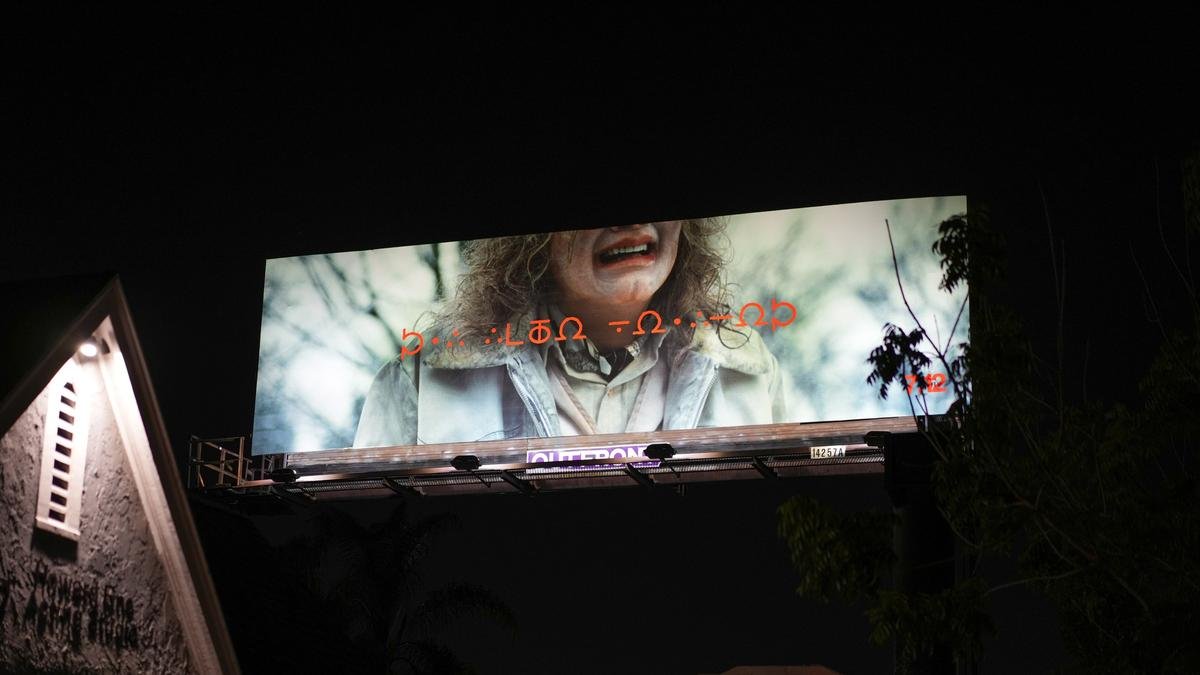
A billboard promoting Osgood Perkins’ upcoming crime-horror, ‘Longlegs’
| Photo Credit: X/ @Longlegsfilm
Let’s admit it; the horror movie marketing playbook is a predictably well-trodden path. Roll out the monster, cue the jump scares, rinse and repeat. Every other horror film pats itself on the back with a prompt, “the scariest of the decade”, flashing across the screen, waxing lyrical of its niche new indie filmmaker’s experimental new take on the genre, “never seen before”.
But Neon has been doing things. Freaky things.
The production company’s marketing team has orchestrated a symphony of suspense that somehow feels like a cold sweat on a sultry summer night. It’s a remarkably Hitchcockian exercise in stoking fear and curiosity, making your skin crawl before a single frame has flickered on the screen. Neon has managed to carve out a unique space for Osgood Perkins’ Longlegs; their approach to the much anticipated crime-horror has been to embrace the unknown and make it the film’s central draw.
The initial teaser was very nonchalantly dropped back in January. It was a visual enigma — a 36-second clip featuring creepy images of blood-soaked rooms and a haunting 911 call. No plot spoilers, no clear hints, just a tantalisingly vague glimpse into something terrifying. Enough to send the internet into a frenzy, with fans dissecting every frame with forensic precision in search for answers.
Neon’s strategy is a love letter to the viral marketing playbooks of found-footage stalwarts, Cloverfield and The Blair Witch Project, where mystery has always been the secret ingredient.
Soon came the posters in February, along with a few more creepy snippets, and then finally a full length trailer in April. They revealed just enough to keep the audience on tenterhooks but never enough to spoil the surprise. This breadcrumb approach kept audiences engaged, forcing them to play detective. It’s a feat, far and few between, in the growing age of instant gratification, where spoilers and overexposure kill a film’s buzz way before its release.
Following this, Neon’s campaign rolled out a series of similarly cryptic releases. Their strategy has been to make the audience an active participant in the horror, inviting them to piece together the puzzle and experience the fear firsthand. Each teaser, each poster, was another enticing taste of its sinister secrets, leading audiences deeper down this twisted rabbit hole.
The pièce de résistance? A phone number on a Los Angeles billboard. Dial it, and you’re treated to Nicolas Cage, in character, whispering niceties in a voice that could curdle milk. It was a brilliant piece of guerrilla marketing that showcased a deep understanding of horror’s primal appeal: the fear of the unknown.
What makes Neon’s campaign a throwback to a golden era of film marketing is its ability to make movies feel special, almost like forbidden fruit. Contrary to digital-age sensibilities, there existed a time when you couldn’t just Google every single detail about a film. You had to wait, breath bated, for the next morsel of information, the next piece of the puzzle. Instant access often dilutes the magic and the Longlegs campaign taps into this almost nostalgic notion and crafts an experience that feels timeless and ridiculously effective.
Neon seems to have played into the film’s strengths beautifully. Even Perkins himself, acknowledged Neon’s brilliance in handling the promotion; in an interview, he revealed that he gave Neon carte blanche to go wild with their strategy, a decision that has clearly paid off.
Then there’s the film itself. Longlegs isn’t just coasting on a wave of clever marketing. Early reviews are in, and critics are singing its praises as a new horror benchmark. Set in the ‘90s, starring Maika Monroe and Nicolas Cage, it’s a dark, satanic serial killer story that essentially seems to inquire: what if the horror in The Silence of the Lambs was on steroids?

Cage, sporting white face paint and delivering lines in a chilling high-pitched voice, plays a killer orchestrating gruesome murders from afar. He has previously described his role as a man “hearing voices” and likened his character to a “possessed Geppetto,” who creates unsettling dolls. By keeping Cage’s character largely hidden in promotional material, they’ve built an aura of malice and menace around him, unlike anything we’ve ever seen him do before (and this is Nic Cage we’re talking about).
The reactions from early screenings have also been nothing short of traumatic. Attendees have taken to social media, dubbing Longlegs an unsurprising, “scariest film of the year”, only this time, there may have been some semblance of truth to their praise.
X has been extolling the film’s horrifying experience ever since, with each description more outrageous than the previous. Many have waxed lyrical over Perkins’ atmosphere of relentless dread and meticulously crafted scares that feel spawned by the Antichrist itself. Reports of audience members crying and fleeing the theatre in terror have only added to the film’s lore.
As we approach the film’s mid-July release, the buzz shows no signs of slowing. Lately, marketing strategies for film and TV have moulded us into cynics where hype inevitably and inadvertently translates to disappointment in a majority of cases. But Longlegs seems to have already cemented its position as a must-watch theatrical experience. It feels like a genuine ‘major motion picture event’ that can be trusted to deliver on its murky promises and then some.
Longlegs hits theatres on July 12.




